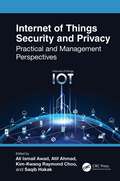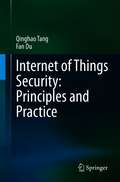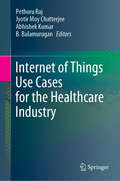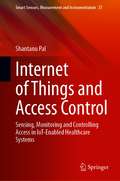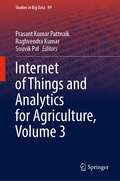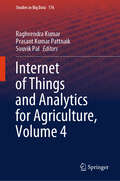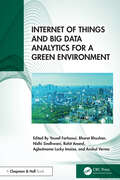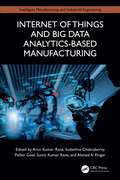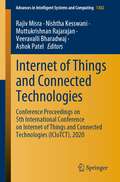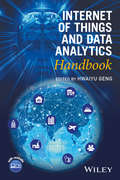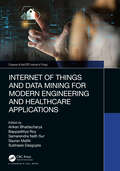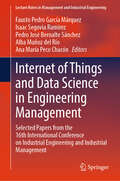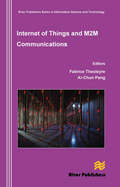- Table View
- List View
Internet of Things Integrated Augmented Reality (SpringerBriefs in Applied Sciences and Technology)
by Nilanjan Dey Gitanjali Rahul Shinde Prashant Shantaram Dhotre Parikshit Narendra MahalleThis book discusses the use of converged technology, a rapidly growing area that enhancements smart devices, communication, Internet of things (IoT), and augmented reality (AR). The book also explores the need for convergence of IoT and AR for various purposes, like personalized services, context awareness, and bridging the gap between the physical and digital world. Furthermore, it examines the implementation of IoT and AR in use cases to define pathways that allow application developers to design modern solutions to satisfy requirements like scalability, abstraction and security. Featuring an introduction, and covering sensing techniques, and effective architecture in AR-based IoT real-time use cases, the book also addresses the issues and challenges in designing standard architecture and middleware to support diverse applications. Given its scope, it is a valuable resource for teachers and students in engineering, as well as researchers, developers, and users working in multi-disciplinary areas.
Internet of Things Security and Data Protection (Internet of Things)
by Sébastien ZieglerThis book provides an overview of the most recent developments in Internet of Things (IoT) security and data protection. It presents the results of several international research projects addressing this topic from complementary angles. It starts by analyzing the main privacy and security threats on IoT, as well as the evolution of data protection norms, such as the European General Data Protection Regulation (GDPR), and their impact on IoT. Through a comprehensive and systematic approach, the contributors present new perspectives on IoT & Cloud Computing security requirements. They discuss the most recent approach to support trusted IoT, including new models of privacy risk assessment, labeling and certification, and contractual tools (such as Privacy PACT). Practical implementations, such as in the European Large Scale Pilots on IoT for Smart Cities (Synchronicity), are presented, explaining how they address security, privacy and data protection. Finally, innovative models to secure IoT systems are presented for the network and end-nodes security, including network threats analysis.
Internet of Things Security and Privacy: Practical and Management Perspectives
by Ali Ismail Awad Kim-Kwang Raymond Choo Saqib Hakak Atif AhmadThe Internet of Things (IoT) concept has emerged partly due to information and communication technology developments and societal needs, expanding the ability to connect numerous objects. The wide range of facilities enabled by IoT has generated a vast amount of data, making cybersecurity an imperative requirement for personal safety and for ensuring the sustainability of the IoT ecosystem. This book covers security and privacy research in the IoT domain, compiling technical and management approaches, addressing real-world problems, and providing practical advice to the industry. This book also includes a collection of research works covering key emerging trends in IoT security and privacy that span the entire IoT architecture layers, focusing on different critical IoT applications such as advanced metering infrastructure and smart grids, smart locks, and cyber-physical systems. The provided state-of-the-art body of knowledge is essential for researchers, practitioners, postgraduate students, and developers interested in the security and privacy of the IoT paradigm, IoT-based systems, and any related research discipline. This book is a valuable companion and comprehensive reference for postgraduate and senior undergraduate students taking an advanced IoT security and privacy course.
Internet of Things Security: Architectures and Security Measures (Advances in Computer Science and Technology)
by Chuan-Kun WuThis book presents a systematic and comprehensive overview for IoT security. It first introduces architecture approaches for IoT and IoT security, describing the security techniques for different layers in the IoT security architecture. It also provides an in-depth analysis on the difference between IoT security and traditional system and data security. It is commonly known that information security includes data confidentiality, data integrity, and availability, and that measures include non-repudiation and access control. However, in practical IoT system construction, many more security measures need to be carefully considered. As such, this book presents around 60 different security measures, mainly focusing on the sensor layer of IoT. These security measures can serve as a source of reference for IoT system construction, as well as IoT security standard making.
Internet of Things Security: Challenges, Advances, and Analytics
by Chintan Patel Nishant DoshiMost of the devices in the Internet of Things will be battery powered sensor devices. All the operations done on battery powered devices require minimum computation. Secure algorithms like RSA become useless in the Internet of Things environment. Elliptic curve based cryptography emerges as a best solution for this problem because it provides higher security in smaller key size compare to RSA. This book focuses on the use of Elliptic Curve Cryptography with different authentication architectures and authentication schemes using various security algorithms. It also includes a review of the math required for security and understanding Elliptic Curve Cryptography.
Internet of Things Security: Principles and Practice
by Qinghao Tang Fan DuOver the past few years, Internet of Things has brought great changes to the world. Reports show that, the number of IoT devices is expected to reach 10 billion units within the next three years. The number will continue to rise and wildly use as infrastructure and housewares with each passing day, Therefore, ensuring the safe and stable operation of IoT devices has become more important for IoT manufacturers. Generally, four key aspects are involved in security risks when users use typical IoT products such as routers, smart speakers, and in-car entertainment systems, which are cloud, terminal, mobile device applications, and communication data. Security issues concerning any of the four may lead to the leakage of user sensitive data. Another problem is that most IoT devices are upgraded less frequently, which leads it is difficult to resolve legacy security risks in short term. In order to cope with such complex security risks,Security Companies in China, such as Qihoo 360, Xiaomi, Alibaba and Tencent, and companies in United States, e.g. Amazon, Google, Microsoft and some other companies have invested in security teams to conduct research and analyses, the findings they shared let the public become more aware of IoT device security-related risks. Currently, many IoT product suppliers have begun hiring equipment evaluation services and purchasing security protection products. As a direct participant in the IoT ecological security research project, I would like to introduce the book to anyone who is a beginner that is willing to start the IoT journey, practitioners in the IoT ecosystem, and practitioners in the security industry. This book provides beginners with key theories and methods for IoT device penetration testing; explains various tools and techniques for hardware, firmware and wireless protocol analysis; and explains how to design a secure IoT device system, while providing relevant code details.
Internet of Things Use Cases for the Healthcare Industry
by Pethuru Raj Abhishek Kumar Jyotir Moy Chatterjee B. BalamuruganThis book explores potentially disruptive and transformative healthcare-specific use cases made possible by the latest developments in Internet of Things (IoT) technology and Cyber-Physical Systems (CPS). Healthcare data can be subjected to a range of different investigations in order to extract highly useful and usable intelligence for the automation of traditionally manual tasks. In addition, next-generation healthcare applications can be enhanced by integrating the latest knowledge discovery and dissemination tools. These sophisticated, smart healthcare applications are possible thanks to a growing ecosystem of healthcare sensors and actuators, new ad hoc and application-specific sensor and actuator networks, and advances in data capture, processing, storage, and mining. Such applications also take advantage of state-of-the-art machine and deep learning algorithms, major strides in artificial and ambient intelligence, and rapid improvements in the stability and maturity of mobile, social, and edge computing models.
Internet of Things and Access Control: Sensing, Monitoring and Controlling Access in IoT-Enabled Healthcare Systems (Smart Sensors, Measurement and Instrumentation #37)
by Shantanu PalThis book presents the design and development of an access control architecture for the Internet of Things (IoT) systems. It considers the significant authentication and authorization issues for large-scale IoT systems, in particular, the need for access control, identity management, delegation of access rights and the provision of trust within such systems. It introduces a policy-based access control approach for the IoT that provides fine-grained access for authorized users to services while protecting valuable resources from unauthorized access. Further, the book discusses an identity-less, asynchronous and decentralized delegation model for the IoT leveraging the advantage of blockchain technology. It also presents an approach of attribute-based identity and examines the notion of trust in an IoT context by considering the uncertainty that exists in such systems. Fully explaining all the techniques used, the book is of interest to engineers, researchers and scientists working in the field of the wireless sensor networks, IoT systems and their access control management.
Internet of Things and Analytics for Agriculture, Volume 2 (Studies in Big Data #67)
by Prasant Kumar Pattnaik Raghvendra Kumar Souvik PalThis book addresses major challenges faced by farmers and the technological solutions based on Internet of Things (IoT). A major challenge in agriculture is cultivating and supplying high-quality produce at the best. Currently, around 50% of global farm produce never reaches the end consumer due to wastage and suboptimal prices. The book presents solutions that reduce the transport costs, improve the predictability of prices based on data analytics and the current market conditions, and reduce the number of middle steps and agents between the farmer and the end consumer. It discusses the design of an IoT-based monitoring system to analyze crop environments and a method to improve the efficiency of decision-making by analyzing harvest statistics. Further, it explores climate-smart methods, known as smart agriculture, that have been adopted by a number of Indian farmers.
Internet of Things and Analytics for Agriculture, Volume 3 (Studies in Big Data #99)
by Prasant Kumar Pattnaik Raghvendra Kumar Souvik PalThe book discusses one of the major challenges in agriculture which is delivery of cultivate produce to the end consumers with best possible price and quality. Currently all over the world, it is found that around 50% of the farm produce never reaches the end consumer due to wastage and suboptimal prices. The authors present solutions to reduce the transport cost, predictability of prices on the past data analytics and the current market conditions, and number of middle hops and agents between the farmer and the end consumer using IoT-based solutions. Again, the demand by consumption of agricultural products could be predicted quantitatively; however, the variation of harvest and production by the change of farm's cultivated area, weather change, disease and insect damage, etc., could be difficult to be predicted, so that the supply and demand of agricultural products has not been controlled properly. To overcome, this edited book designed the IoT-based monitoring system to analyze crop environment and the method to improve the efficiency of decision making by analyzing harvest statistics. The book is also useful for academicians working in the areas of climate changes.
Internet of Things and Analytics for Agriculture, Volume 4 (Studies in Big Data #176)
by Prasant Kumar Pattnaik Raghvendra Kumar Souvik PalThis edited book presents recent findings on use of IoT-based monitoring systems to analyse functional frameworks for intelligent computational analysis of sustainable agricultural system, field monitoring and automation systems, agriculture sensor network, sensor-based precision agriculture, expert systems for soil management, remote monitoring and predictive analysis systems, AI-based emergency alert systems, crop monitoring, AI-based predictive analysis, smart irrigation, and data acquisition security. The book also explores a range of applications, including, intelligent field monitoring, intelligent data processing and sensor technologies, predictive analysis systems, crop monitoring, and weather data-enabled analysis in IoT agro-systems.
Internet of Things and BDS Application
by Bo Wang Xiangsheng Liu Yaqi ZhangThe book focuses on the Internet of Things and Beidou system application. Both principles and engineering practice have been addressed, with more weight placed on engineering practice. This is achieved by providing in-depth studies on a number of major topics of Beidou system application with the Internet of Things. Such comprehensive and systematic analysis is particularly suited for readers who are interested to learn practical solutions in Beidou system application. The book can benefit researchers, engineers, and graduate students in the fields of positioning and navigation, geospatial engineering, telecommunications, etc.
Internet of Things and Big Data Analytics for a Green Environment
by Bharat Bhushan Anshul Verma Yousef Farhaoui Agbotiname Lucky Imoize Nidhi Sindhwani Rohit AnandThis book studies the evolution of sustainable green smart cities and demonstrates solutions for green environmental issues using modern industrial IoT solutions. It is a ready reference with guidelines and a conceptual framework for context-aware product development and research in the IoT paradigm and Big Data Analytics for a Green Environment. It brings together the most recent advances in IoT and Big Data in Green Environments, emerging aspects of the IoT and Big Data for Green Cities, explores key technologies, and develops new applications in this research field.Key Features:• Discusses the framework for development and research in the IoT Paradigm and Big Data Analytics.• Highlights threats to the IoT architecture and Big Data Analytics for a Green Environment. • Present the I-IoT architecture, I-IoT applications, and their characteristics for a Green Environment. • Provides a systematic overview of the state-of-the-art research efforts.• Introduces necessary components and knowledge to become a vital part of the IoT revolution for a Green Environment.This book is for professionals and researchers interested in the emerging technology of sustainable development, green cities, and Green Environment.
Internet of Things and Big Data Analytics-Based Manufacturing (Intelligent Manufacturing and Industrial Engineering)
by Ahmed A. Elngar Arun Kumar Rana Sudeshna Chakraborty Pallavi Goel Sumit Kumar RanaBy enabling the conversion of traditional manufacturing systems into contemporary digitalized ones, Internet of Things (IoT) adoption in manufacturing creates huge economic prospects through reshaping industries. Modern businesses can more readily implement new data-driven strategies and deal with the pressure of international competition thanks to Industrial IoT. But as the use of IoT grows, the amount of created data rises, turning industrial data into Industrial Big Data.Internet of Things and Big Data Analytics-Based Manufacturing shows how Industrial Big Data can be produced as a result of IoT usage in manufacturing, considering sensing systems and mobile devices. Different IoT applications that have been developed are demonstrated and it is shown how genuine industrial data can be produced, leading to Industrial Big Data. This book is organized into four sections discussing IoT and technology, the future of Big Data, algorithms, and case studies demonstrating the use of IoT and Big Data in a variety of industries, including automation, industrial manufacturing, and healthcare.This reference title brings all related technologies into a single source so that researchers, undergraduate and postgraduate students, academicians, and those in the industry can easily understand the topic and further their knowledge.
Internet of Things and Big Data Applications: Recent Advances and Challenges (Intelligent Systems Reference Library #180)
by Raghvendra Kumar Valentina E. Balas Vijender Kumar SolankiThis book provides essential future directions for IoT and Big Data research. Thanks to rapid advances in sensors and wireless technology, Internet of Things (IoT)-related applications are attracting more and more attention. As more devices are connected, they become potential components for smart applications. Thus, there is a new global interest in these applications in various domains such as health, agriculture, energy, security and retail. The main objective of this book is to reflect the multifaceted nature of IoT and Big Data in a single source. Accordingly, each chapter addresses a specific domain that is now being significantly impacted by the spread of soft computing
Internet of Things and Connected Technologies: Conference Proceedings on 5th International Conference on Internet of Things and Connected Technologies (ICIoTCT), 2020 (Advances in Intelligent Systems and Computing #1382)
by Ashok Patel Rajiv Misra Muttukrishnan Rajarajan Nishtha Kesswani Veeravalli BharadwajThis book presents the recent research adoption of a variety of enabling wireless communication technologies like RFID tags, BLE, ZigBee, etc., and embedded sensor and actuator nodes, and various protocols like CoAP, MQTT, DNS, etc., that has made Internet of things (IoT) to step out of its infancy to become smart things. Now, smart sensors can collaborate directly with the machine without human involvement to automate decision making or to control a task. Smart technologies including green electronics, green radios, fuzzy neural approaches, and intelligent signal processing techniques play important roles in the developments of the wearable healthcare systems. In the proceedings of 5th International Conference on Internet of Things and Connected Technologies (ICIoTCT), 2020, brought out research works on the advances in the Internet of things (IoT) and connected technologies (various protocols, standards, etc.). This conference aimed at providing a forum to discuss the recent advances in enabling technologies and applications for IoT.
Internet of Things and Connected Technologies: Conference Proceedings on 6th International Conference on Internet of Things and Connected Technologies (ICIoTCT), 2021 (Lecture Notes in Networks and Systems #340)
by Bharadwaj Veeravalli Ashok Patel Rajiv Misra Muttukrishnan Rajarajan Nishtha KesswaniThis book presents recent advances on IoT and connected technologies. We are currently in the midst of the Fourth Industrial Revolution, and IoT is having the most significant impact on our society. The recent adoption of a variety of enabling wireless communication technologies like RFID tags, BLE, ZigBee, etc., embedded sensor and actuator nodes, and various protocols like CoAP, MQTT, DNS, etc., has made the Internet of things (IoT) step out of its infancy. Internet of things (IoT) and connecting technologies are already having profound effects on the different parts of society like the government, health care, businesses, and personal lives. 6th International Conference on Internet of Things and Connected Technologies (ICIoTCT), 2021, was a platform to discuss and feature research on topics such as augmented reality, sensor networks, and wearable technology. This book is ideally designed for marketing managers, business professionals, researchers, academicians, and graduate-level students seeking to learn how IoT and connecting technologies increase the amount of data gained through devices, enhance customer experience, and widen the scope of IoT analytics in enhancing customer marketing outcomes.
Internet of Things and Cyber Physical Systems: Security and Forensics (Advances in Cybersecurity Management)
by Yassine Maleh Akashdeep Bhardwaj Keshav Kaushik Susheela DahiyaThe quantity, diversity, and sophistication of Internet of Things (IoT) items are rapidly increasing, posing significant issues but also innovative solutions for forensic science. Such systems are becoming increasingly common in public locations, businesses, universities, residences, and other shared offices, producing enormous amounts of data at rapid speeds in a variety of forms. IoT devices can be used as suspects, digital witnesses, or instruments of crime and cyberattacks, posing new investigation problems, forensic issues, security threats, legal concerns, privacy concerns, and ethical dilemmas. A cyberattack on IoT devices might target the device itself or associated systems, particularly vital infrastructure. This book discusses the advancements in IoT and Cyber Physical Systems (CPS) forensics. The first objective is to learn and understand the fundamentals of IoT forensics. This objective will answer the question of why and how IoT has evolved as one of the most promising and widely accepted technologies across the globe and has many widely accepted applications. The second objective is to learn how to use CPS to address many computational problems. CPS forensics is a promising domain, and there are various advancements in this field. This book is structured so that the topics of discussion are relevant to each reader’s particular areas of interest. The book’s goal is to help each reader to see the relevance of IoT and CPS forensics to his or her career or interests. This book not only presents numerous case studies from a global perspective, but it also compiles a large amount of literature and research from a database. As a result, this book effectively demonstrates the concerns, difficulties, and trends surrounding the topic while also encouraging readers to think globally. The main goal of this project is to encourage both researchers and practitioners to share and exchange their experiences and recent studies between academia and industry.
Internet of Things and Data Analytics Handbook
by Hwaiyu GengThis book examines the Internet of Things (IoT) and Cyber-Physical Systems (CPS) from a technical, economical and application point of view Examines cloud computing, data analytics, and sustainability and how they relate to IoT/CPS Covers the scope of both consumer IoT and enterprise/government CPS applications Includes best practices, business model and real-world case studies
Internet of Things and Data Mining for Modern Engineering and Healthcare Applications (Chapman & Hall/CRC Internet of Things)
by Ankan Bhattacharya, Bappadittya Roy, Samarendra Nath Sur, Saurav Mallik and Subhasis DasguptaThis book focuses on Internet of Things (IoT) and data mining for modern engineering and healthcare applications, recent technological advancements in microwave engineering and communication, and applicability of newly developed solid-state technologies in biomedical engineering and healthcare for day-to-day applications. The reader will be able to know the recent advancements in microwave engineering, including novel techniques in microwave antenna design and various aspects of microwave propagation. This book aims to showcase various aspects of communication, networking, data mining, computational biology, bioinformatics, biostatistics and machine learning. Day-to-day applicability of modern communication and networking technologies is a matter of prime concern. This book covers recent trends in solid-state technologies, VLSI and the applicability of modern electronic devices and biosensing devices in bioinformatics and smart healthcare. Furthermore, it showcases the modern optimization techniques in power system engineering and machine design and discusses the role of solid-state engineering in the development of modern electronic gadgets. Societal benefits of microwave technologies for smooth and hustle-free life are also majorly focused areas. This book will be of high interest to the researchers, academicians, scientists and industrialists as well who are involved in the role of IoT for modern engineering applications. Features: This book features Internet of Things (IoT) and data mining for modern engineering and healthcare applications, recent technological advancements in microwave engineering and communication, and applicability of newly developed solid-state technologies in biomedical engineering and smart healthcare technologies. It showcases the novel techniques in Internet of Things (IoT)-integrated microwave antenna design and various aspects of microwave communication. It highlights the role of Internet of Things (IoT) in various aspects of communication, networking, data mining, computational biology, bioinformatics, biostatistics and machine learning. It reviews the role of Internet of Things (IoT) in solid-state technologies and VLSI and the applicability of modern electronic devices in bioinformatics and healthcare. It highlights the role of Internet of Things (IoT) in power system engineering, optics, RF and microwave energy harvesting and smart biosensing technologies.
Internet of Things and Data Science in Engineering Management: Selected Papers from the 16th International Conference on Industrial Engineering and Industrial Management (Lecture Notes in Management and Industrial Engineering)
by Fausto Pedro García Márquez Pedro José Bernalte Sánchez Alba Muñoz del Río Isaac Segovia Ramirez Ana María Peco ChacónThis book is a compilation of expansions of the best papers presented at the 16th International Conference on Industrial Engineering and Industrial Management, which took place on-line on 7th and 8th July 2022. The conference was organized by the Universidad de Castilla-La Mancha, Spain. IoT and Data Science in Engineering Management highlights the latest research advances and analyses of real-world case studies in industrial engineering and industrial management from a wide range of international contexts. It also identifies business applications and the latest findings and innovations in operations management and the decision sciences. The contributing authors report their findings on subjects as diverse as sustainability and eco-efficiency, information systems and knowledge management, education in organizational engineering and the circular economy.
Internet of Things and Fog Computing-Enabled Solutions for Real-Life Challenges
by Vivek Kumar Ajay Rana Anil Saroliya Gutiérrez Calderón, José SebastiánIn today’s world, the use of technology is growing rapidly, and people need effective solutions for their real-life problems. This book discusses smart applications of associated technologies to develop cohesive and comprehensive solutions for the betterment of humankind. It comprehensively covers the effective use of the Internet of Things (IoT), wireless sensor network, wearable sensors, body area network, cloud computing, and distributed computing methodologies. The book comprehensively covers IoT and fog computing sensor supported technologies or protocols including web of things, near-field communication, 6LoWPAN, LoRAWAN, XMPP, DDS, LwM2M, Mesh Protocol, and radio-frequency identification. The book- Discusses smart applications to develop cohesive and comprehensive solutions for real-life problems. Covers analytical descriptions with appropriate simulation and prototype models. Examines the role of IoT and fog computing technologies during global emergency situations. Discusses key technologies including cloud computing, 5G communication, big data, artificial intelligence, control systems, and wearable sensors. The text is primarily written for graduate students, and academic researchers working in diverse fields of electrical engineering, biomedical engineering, electronics and communication engineering, computer engineering, and information technology.
Internet of Things and Its Applications: Select Proceedings of ICIA 2020 (Lecture Notes in Electrical Engineering #825)
by Sanjay Kumar Debasis Giri Sarmistha Neogy Keshav Dahal Subrata DuttaThis volume constitutes selected papers presented at the International Conference on IoT and its Applications 2020. The research papers presented were carefully reviewed and selected from several initial submissions on the topics - the Internet of Things (IoT) and its applications such as smart cities, smart devices, agriculture, transportation and logistics, healthcare, etc. The book contains peer-reviewed chapters written by leading international scholars from around the world. This book will appeal to students, practitioners, industry professionals, and researchers working in the field of IoT and its integration with other technologies to develop comprehensive solutions to real-life problems.
Internet of Things and M2M Communication Technologies: Architecture and Practical Design Approach to IoT in Industry 4.0
by Veena S. ChakravarthiThis book provides readers with a 360-degree perspective on the Internet of Things (IoT) design and M2M communication process. It is intended to be used as a design guide for the development of IoT solutions, covering architecture, design, and development methods. This book examines applications such as industry automation for Industry 4.0, Internet of Medical Things (IoMT), and Internet of Services (IoS) as it is unfolding. Discussions on engineering fundamentals are limited to what is required for the realization of IoT solutions. Internet of Things and M2M Communication Technologies: Architecture and Practical Design Approach to IoT in Industry 4.0 is written by an industry veteran with more than 30 years of hands-on experience. It is an invaluable guide for electrical, electronic, computer science, and information science engineers who aspire to be IoT designers and an authoritative reference for practicing designers working on IoT device development.Provides complete design approach to develop IoT solutions;Includes reference designs and guidance on relevant standards compliance;Addresses design for manufacturability and business models.
Internet of Things and M2m Communications
by Ai-Chun Pang Fabrice TheoleyreThe Internet of Things is the emerging technology which interconnects smart objects using wireless communications. After having been extensively studied in academic labs, the Internet of Things is now widely applied in the industrial world (e.g. domestic automation, smart metering, smart cities).


